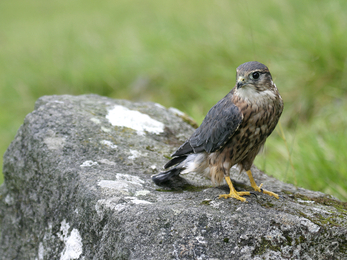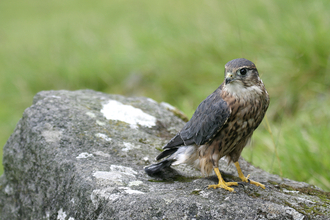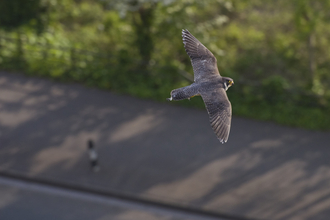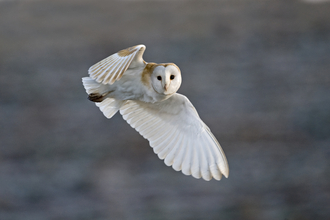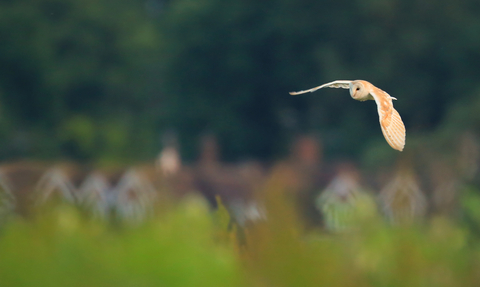
© Jon Hawkins - Surrey Hills Photography
Where to see birds of prey
Raptors
Raptors and owls are the highly-skilled hunters of the avian world. Whether it's nest building, courtship displays, aerial prowess or high-speed ambush flights you’re after, birds of prey offer magnificent spectacles at all times of year, even during the depths of winter. Although famously solitary animals, hunting solo, proud and aloof, this is not always the case. Head east to experience one of the greatest concentrations of birds of prey in the country, where raptors gather just before dusk in great gatherings.
It’s in this magical hour, as the sun heads for the horizon and for a precious few minutes transforms the reeds with a warm fiery glow, that a great wildlife gathering takes place
Find raptor sites near you
Do a little research in advance and find out the best place to raptors in England, Scotland and Wales.
North
Cheshire Wildlife Trust
Dutton Farm Park - A mixture of wildflower meadow and water habitats. Nestled below the imposing Grade II listed Dutton viaduct, this reserve is a haven for birds and other wildlife. Peregrine falcons have been known to use the viaduct as a vantage point, and kestrels and buzzards are regular visitors.
Cumbria Wildlife Trust
Humphrey Head - The limestone cliffs which dominate this reserve provide ideal breeding habitat for peregrine falcons. The exposed headland also provides excellent views of the nearby estuary to Morecambe Bay, where incoming tides push waders closer to shore.
Foulshaw Moss - The UK’s most important raised mire and home to a host of birds of prey. Raptors can be seen year round. Up to seven ospreys have been spotted in autumn, hobby and kestrel in summer and hen harrier and short-eared owl in winter. Other visitors include buzzards, peregrines, marsh harrier, red kite, goshawk and merlin joining resident tawny and barn owl.
Northumberland Wildlife Trust
Whitelee Moor - This 1510ha NNR and SSSI is the Trust’s largest reserve and is notable for its active blanket bog and heather heaths. Sightings of merlin, hen harrier, buzzard, kestrel and sparrowhawk are all possible here.
Tees Valley Wildlife Trust
Portrack Marsh - A restored former industrial area combined with some original marsh. Most of it floods in winter, attracting hundreds of teal, other ducks, and snipe. You may see kestrel, sparrowhawk, marsh harrier and short-eared owl hunting over the marshland.
Yorkshire Wildlife Trust
Spurn Point - A famous shingle bank in the Humber estuary where merlin, peregrine and hen harrier can be seen hunting the large flocks of waders and small birds during the winter months. Honey and rough-legged buzzard, hobby, osprey and rarities are also all possible during spring and autumn migrations.
Wheldrake Ings - Great for peregrine in the winter which seek out prey from the huge flocks of golden plover, lapwing, teal and wigeon, and a great chance of merlin, sparrowhawk and common buzzard. During spring and summer, red kite, marsh harrier and hobby are regularly seen, and osprey and hen harrier are seen on migration.
Adel Dam - A little gem of a woodland and wetland nature reserve. Stroll among dramatic high canopy trees planted as a victorian garden, enjoy close up views of the bird feeding station, popular with woodpeckers and mandarin duck, then overlook the lake with an almost guaranteed sighting of the resident kingfishers.
Midlands
Derbyshire Wildlife Trust
Woodside Farm Nature Reserve - Several owl species have been spotted on this farm and nature reserve, including little owl, barn owl, short-eared owl and long-eared owl. Various other raptor species are also regularly sighted, including kestrel and buzzard. A viewing tower offers commanding views over the reserve, making it a great place to scan for birds of prey.
Leicestershire & Rutland Wildlife Trust
Rutland Water Nature Reserve - While breeding ospreys are a sight confined to the spring and summer months, no bird of prey guide would be complete without a mention of Rutland Water. Visit in winter for a chance to see barn or short-eared owls, sparrowhawks, peregrines, kestrels, buzzards and red kites.
Kelham Bridge Nature Reserve - Although the reserve is in its infancy, the potential of the site is already being seen. Raptors are a speciality of Kelham Bridge and marsh, hen and Montagu’s harrier, osprey, red-footed falcon, merlin, peregrine and buzzard have all been recorded here. The bird list for the reserve currently stands at 101 species.
Lincolnshire Wildlife Trust
Gibraltar Point National Nature Reserve - An excellent site for seeing birds of prey on passage, including buzzards, marsh and hen harriers, red kite and osprey. The reserve boasts all five species of native owl and has hosted rarities including snowy owl, white-tailed eagle, rough-legged buzzard and black kite.
Anderby Marsh - Visit for marsh harriers over the reedbeds in summer and hen harriers in winter. Peregrines and merlins are also present in winter. Being a key migrant site, surprises often drift down the coast, including black kites or the odd white-tailed eagle. Watch the marsh from the Round-and-Round Hide.
Staffordshire Wildlife Trust
Loynton Moss - This SSSI mainly consists of an area of Moss, which is a regional term for peaty, boggy land. The wetland habitat supports a range of insect and bird species, and kestrel and buzzard hunt amongst the rich grassland. By raising water levels, it is hoped that wading birds such as curlew and snipe will also be attracted here.
Worcestershire Wildlife Trust
Upton Warren - Lake complex in two distinct parts, giving the best bird watching in the county. There are many winter wildfowl, with peregrine, buzzard, sparrowhawk and kestrel often seen from the hides. Entrance is by WWT membership card of £3 permit on the day or in advance online.
South
Avon Wildlife Trust
Folly Farm - Unspoiled working farm and flagship reserve with old woodland and rare flower meadows, attracting buzzard, kestrel, barn and tawny owl. Rough grassland has been left uncut to provide a `barn owl corridor’ where small mammals such as field vole, mice and shrews thrive.
Berks, Bucks & Oxon Wildlife Trust
Warburg Nature Reserve - Remote wooded valley in the Chilterns with a thriving red kite and buzzard population. You can often watch aerial disputes between the two species over the forest and grassland, allowing direct comparison of their key identification features.
Cornwall Wildlife Trust
Hawkes Wood Nature Reserve - A delightful old oak woodland near Wadebridge with two streams and a quarry. The oak coppice is characteristic of many Cornish woods and supports specialists such as pipistrelle bats. This is an exceptional area for woodland birds, including tawny owls which regularly breed here.
Devon Wildlife Trust
Dawlish Inner Warren - The spit that juts out across the mouth of the Exe Estuary is known as Dawlish Warren. DWT owns 32 hectares of the inward side of the spit known as Inner Warren and a further 81 hectares of mudflat and salt marsh on the north side. Look out for peregrines hunting for wildfowl and wading birds amongst flocks up to 12,000 strong.
Dorset Wildlife Trust
Lorton Meadows - The county’s top reserve for raptor spotting, with breeding kestrel, tawny and barn owl (all of which have featured on live webcams), common sightings of buzzard and sparrowhawk, and a chance of seeing marsh harrier, peregrine and short-eared owl.
Gloucestershire Wildlife Trust
Coombe Hill Canal & Meadows - An ancient landscape fringing the Severn, Coombe Hill Canal and Meadows is a place of vistas and endless skies, floods and farming. It is a very special site for wetland birds, particularly waders and migrating waterfowl. These of course attract attention; watch out for birds of prey including hen harrier, peregrine falcon and goshawk.
Hampshire Wildlife Trust
Farlington Marshes - One of the Solent’s prime bird locations – a grazing marsh and high-tide refuge for thousands of waders and wildfowl in winter. It’s also a great place to see peregrine falcons: look out for young peregrines learning to hunt and causing chaos by frightening huge flocks of potential prey.
Somerset Wildlife Trust
Westhay Moor National Nature Reserve - Huge flocks of starlings on the Somerset Levels in autumn and winter mean this wetland nature reserve is a great place to see birds of prey, including peregrines, sparrowhawks and buzzards, along with barn owls. These hunters cause the starling murmurations to shape-shift in the sky.
Surrey Wildlife Trust
Barossa & Poors Allotments - This large heathland habitat with wet areas, woodland and scrub is designated as a Special Protection Area (SPA) and Site of Special Scientific Interest (SSSI). Great for hobby, kestrel, sparrowhawk, buzzard, great grey shrike, red kite and tawny owl. Goshawk has also been recorded on the site.
Wiltshire Wildlife Trust
Blakehill Nature Reserve - The largest of Wiltshire WT’s 40 nature reserves and also one of the UK’s biggest grassland restoration projects. This 240-hectare site is one of the biggest expanses of hay meadow in the UK. A refuge for wildlife including buzzards, kestrels, sparrowhawks, owls, peregrines and merlin in winter.
East
Beds, Cambs & Northants Wildlife Trust
Grafham Water - Anglian Water reservoir surrounded by woodland and grassland, look out for the resident buzzard, red kite, sparrowhawk, tawny and barn owl. Spring and autumn migrants include hobby, peregrine, merlin, osprey (breeding at nearby Rutland Water), short and long-eared owl, and sometimes honey buzzard and marsh harrier.
Essex Wildlife Trust
Fingringhoe Wick - Daily bird of prey sightings usually include peregrine, marsh harrier, sparrowhawk and kestrel with the occasional buzzard, whilst in the winter merlin and hen harrier can be seen. During spring and summer, hobbies are regularly seen hunting the many dragonflies, and osprey can be seen on migration. Barn and little owls also visit.
Hertfordshire Wildlife Trust
Tring Reservoirs Nature Reserve - Four reservoirs fed by natural springs set in the Chilterns, this reserve attracts a huge variety of birds. Wilstone Reservoir is one of the most famous spots for birdwatching in southern England – visit the hide there in early May to get exceptional views of hobbies hunting. Also good for regular sightings of marsh harriers and ospreys.
Norfolk Wildlife Trust
Hickling Broad - The largest expanse of open water in the Broads, with an almost unrivalled raptor spectacle. From near Stubb Mill, you can see up to 100 marsh harriers fly in at sunset to roost on the reserve. Also merlin, hen harrier, barn owl, buzzard, kestrel, sparrowhawk – and around 40 common cranes in the reedbeds.
Cley Marshes - The oldest Wildlife Trust reserve in the country, Cley is a fantastic place for views of marsh harriers, with several birds usually present year-round on the reserve. As well as being seen from the reserve’s network of hides, they can often also be spotted from the comfort of the visitor centre’s panoramic café, and perhaps enjoyed with a coffee and cake.
Suffolk Wildlife Trust
Hen Reedbeds - Hen Reedbeds is a blend of reedbeds, fens, dykes and pools created in 1999 to provide new breeding habitat for bittern and other wildlife. Look out for raptors such as marsh harriers, hobbies and buzzards, as well as appearances by bearded tits and kingfishers.
Snape Marshes - At almost 60 acres, Snape Marshes is a significant new nature reserve, and its location alongside the Alde Estuary adds considerably to its value for wildlife. Barn owls and short-eared owls are amongst the birds of prey possible here, the former of which has already bred in owl boxes on site.
Wales
Montgomeryshire Wildlife Trust
Cors Dyfi - Famous for its water buffalo and osprey in summer (plus honey buzzard), but in winter the tower hide also gives regular sightings of red kite, buzzard, marsh and hen harrier, goshawk, kestrel, sparrowhawk, peregrine and merlin.
Radnorshire Wildlife Trust
Gilfach - The whole reserve is designated as a Special Protection Area (SPA) under the Birds Directive because of its importance for birds of prey and corvids. Look for raven, peregrine, goshawk, red kite, buzzard and merlin, as well as barn and tawny owl.
Wildlife Trust for South and West Wales
Skomer - Puffin lovers beware - large gatherings of puffins and other seabirds attract a variety of aerial predators that are not shy about their business. Look out for peregrine, sparrowhawk, kestrel and buzzard, as well as short-eared owl, raven and greater black-backed gull.
Scotland
Scottish Wildlife Trust
Ben Mor Coigach - Perhaps Scotland’s best winter reserve for birds of prey, with a chance of spotting both merlin and golden eagle. Coigach is SWT’s largest reserve; a huge 6000ha in total. Plants and animals must be hardy to survive this wild place. From its summit, the north west coast is laid out before you.
Northern Ireland
Ulster Wildlife Trust
Isle of Muck - This impressive island nature reserve, off Islandmagee in Co. Antrim, contains the third largest colony of cliff-nesting seabirds in Northern Ireland. Kittiwake, guillemot, fulmar and razorbill all breed here and, perhaps not surprisingly, peregrine falcons commonly hunt over the island.
Ballynahone Bog - Northern Ireland’s second largest area of intact raised bog – teeming with wildlife. Look out for NI priority bird species; hen harrier, curlew, skylark, song thrush, bullfinch, linnet and reed bunting. Catch a glimpse overhead of sparrowhawk, buzzard and kestrel.
The Channel Islands
Alderney Wildlife Trust
Longis Nature Reserve - The bird hides at Mannez and Longis are excellent places to watch nesting wildfowl in summer as well as winter visitors. Many raptors pass through on migration, but there are also resident populations of buzzard, kestrel, peregrine falcon, barn and long-eared owl.
What to look for
Winter can be a great time of year to look for birds of prey. Some species of raptors and owls, such as marsh harriers or long-eared owls, may come together to form collective winter roosts. Others, such as peregrine falcons and merlins, take advantage of flocking waders and water birds arriving at favoured wetland habitat and can be seen hunting in the open.
In spring and summer, our resident raptor species are also boosted by the arrival of migrant birds like hobbies and ospreys, as well as the occasional rarity. Long-lived birds are famed for returning to particular breeding sites, allowing intimate views of nest sites and breeding behaviour in some cases.
If you can't get to these places
It’s still possible to enjoy birds of prey close to home. Whether it is a red kite, twisting her tail as she steers with insolent ease across the sky, a kestrel hovering over a motorway verge or the mewling call of the buzzard above fields and woodland, raptors are all around us. Even those living in city can enjoy the thrill of a peregrine making an anchor silhouette in the sky as she stoops to become the fastest living thing on the planet.
More wildlife experiences
From seeing colourful wildflowers to spotting magnificent birds of prey, we can help you get closer to wildlife across the UK.

